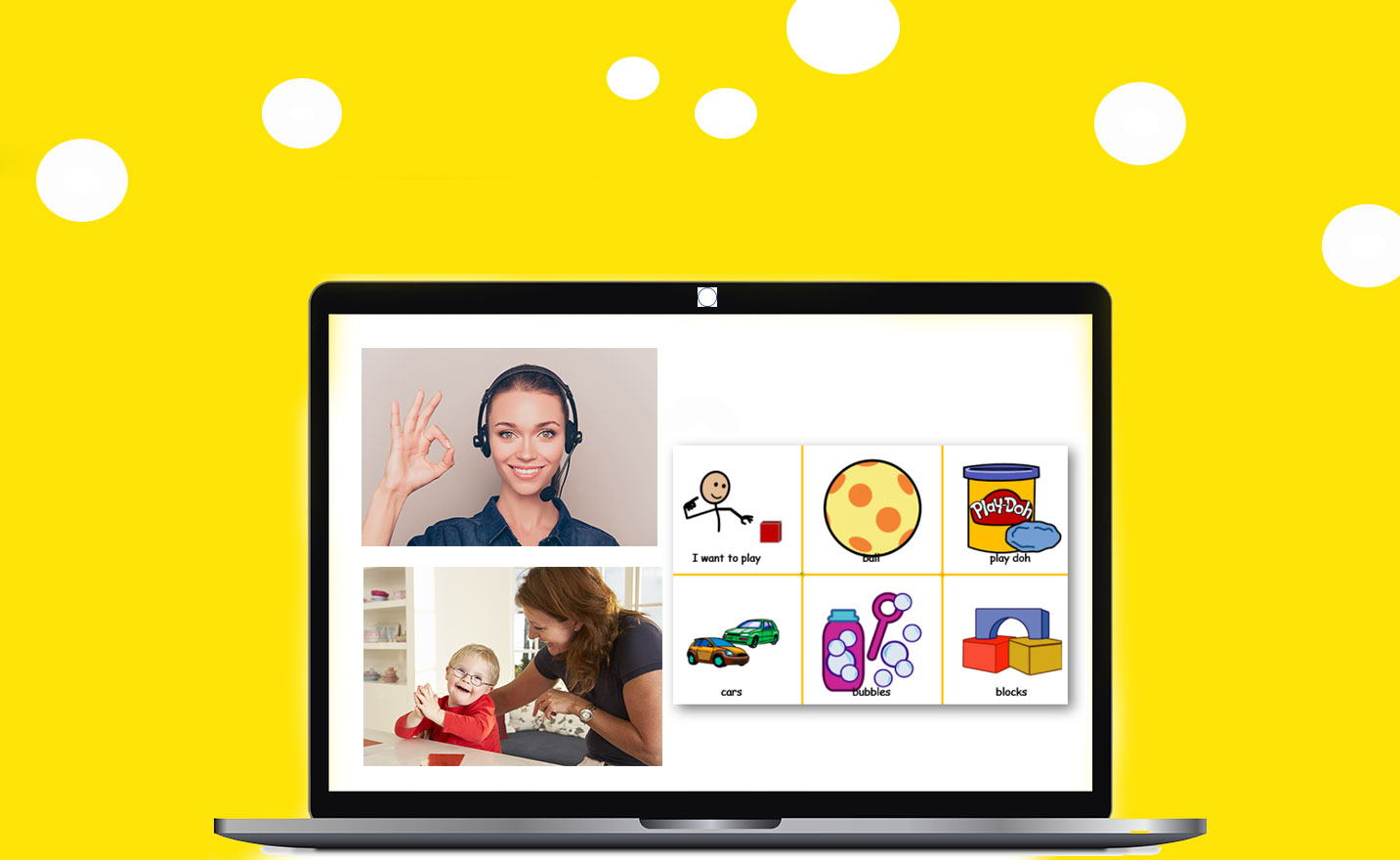

5 Benefits of TeleTherapy
By Cindy Watson, M.Ed, CCC-SLP
While most of my professional career I have provided clinic-based and home-based care, the growing need for alternative care options has led me to explore the benefits of TeleTherapy. I’ll start by mentioning what exactly TeleTherapy is, as many parents may ask. TeleTherapy is therapy treatment provided through a live, audio-visual connection over the internet.
With TeleTherapy, therapists address the same treatment goals as in person, but through the use of electronic devices. The technology is similar to what is used for video calls like Skype or FaceTime, but for TeleTherapy a HIPAA compliant platform must be used. While I love working with kids in person, I have come to appreciate the many benefits of TeleTherapy.
1. TeleTherapy helps ensure consistent treatment.
We know that a key to progress towards therapy goals is consistency. However, this can be challenging for many different reasons. In my role as a therapist, I have seen families struggle with consistency because of a lack of transportation. Others miss therapy because of a compromised immune system, significant allergies, chemotherapy, family scheduling challenges, etc. TeleTherapy gives families the option of receiving services without the obstacles associated with on-site care.
TeleTherapy can be provided in a safe environment for the child. For example, when a child is preparing for a surgery or just completed a surgery, a major goal is to keep them well during the pre-operative and post-operative time to promote healing. TeleTherapy allows children to continue therapy while limiting exposure to illness.
2. Parent and caregiver involvement is promoted.
Parents and caregivers are key players in ensuring successful outcomes with TeleTherapy. They help gather needed supplies and provide reinforcers for the child (high-5’s, verbal praise, tokens, rewards, etc). Caregiver engagement during TeleTherapy serves as a helpful training that is beneficial for carry-over in the patient’s day-to-day life.
3. TeleTherapy promotes carry over of functional skills in a child’s natural environment.
Skills we work on during therapy are intended to be used outside therapy sessions, in the child’s natural environments such as their home, school, and community settings. When this happens the therapist knows that something called ‘carry over’ has happened. Carry over is a key objective in nearly all pediatric therapy treatment plans.
The beauty of TeleTherapy is that sessions often happen in one of the child’s primary natural environments, their home. For example, a child receiving feeding therapy may have TeleTherapy during their normal snack time at home. The caregiver can connect with TeleTherapy while their child is interacting with a toy on the floor in their home. The therapist can offer guidance to the caregiver on ways to strengthen trunk control during a child’s natural floor play time.
4. The TeleTherapy delivery model can be more flexible.
Getting in the car for therapy, driving to therapy, walking through the parking lot, waiting in the lobby… there are a lot of transitions leading up to each therapy session. Because of this many families prefer fewer, but longer treatment sessions each week. In the clinic setting, this is what makes therapy more convenient and therefore more accessible for families.
However, with TeleTherapy the transition time may be as easy as going to your home’s laptop computer or grabbing an ipad. TeleTherapy more easily accommodates shorter, more frequent TeleTherapy sessions if needed. For example a child may benefit from 30 minute sessions three times a week instead of two 45 minute sessions.
5. TeleTherapy provides greater access to qualified providers that might not otherwise be available.
One of the top reasons professional medical organizations saw TeleMedicine as beneficial is that it improved access to qualified providers. This means patients in a rural, remote area can gain access to therapy services that would otherwise not be available. Therapists that specialize and/or have training in a therapeutic approach a patient needs will have more availability for scheduling.
Learn more: TeleTherapy bring Great Kids and Therapists Together!
 About the Author
About the Author
Cindy Watson is a co-founder of Children’s Therapy TEAM. She works diligently to sustain TEAM’s philanthropic outreach in Northwest Arkansas and Internationally. She considers helping kids communicate to be one of her greatest passions in life. Cindy holds a Master’s Degree in Speech Language Pathology from Northeastern State University in Tahlequah, Oklahoma (1995). She is a past Parent Adviser for the Arkansas School for the Deaf (2002-2008) and currently serves as Children’s Therapy TEAM’s Family Support Coordinator. Cindy and her family are active members of Cross Church. Cindy is certified in Interactive Metronome, Picture Exchange Communication System (PECS), Food Chaining and Arkansas School of the Deaf Sky-Hi Trained. One of her many roles at Children’s Therapy TEAM is to ensure that TEAM therapists are kept well informed about on-going professional development opportunities.
5 Benefits of TeleTherapy
By Cindy Watson, M.Ed, CCC-SLP
While most of my professional career I have provided clinic-based and home-based care, the growing need for alternative care options has led me to explore the benefits of TeleTherapy. I’ll start by mentioning what exactly TeleTherapy is, as many parents may ask. TeleTherapy is therapy treatment provided through a live, audio-visual connection over the internet.
With TeleTherapy, therapists address the same treatment goals as in person, but through the use of electronic devices. The technology is similar to what is used for video calls like Skype or FaceTime, but for TeleTherapy a HIPAA compliant platform must be used. While I love working with kids in person, I have come to appreciate the many benefits of TeleTherapy.
1. TeleTherapy helps ensure consistent treatment.
We know that a key to progress towards therapy goals is consistency. However, this can be challenging for many different reasons. In my role as a therapist, I have seen families struggle with consistency because of a lack of transportation. Others miss therapy because of a compromised immune system, significant allergies, chemotherapy, family scheduling challenges, etc. TeleTherapy gives families the option of receiving services without the obstacles associated with on-site care.
TeleTherapy can be provided in a safe environment for the child. For example, when a child is preparing for a surgery or just completed a surgery, a major goal is to keep them well during the pre-operative and post-operative time to promote healing. TeleTherapy allows children to continue therapy while limiting exposure to illness.
2. Parent and caregiver involvement is promoted.
Parents and caregivers are key players in ensuring successful outcomes with TeleTherapy. They help gather needed supplies and provide reinforcers for the child (high-5’s, verbal praise, tokens, rewards, etc). Caregiver engagement during TeleTherapy serves as a helpful training that is beneficial for carry-over in the patient’s day-to-day life.
3. TeleTherapy promotes carry over of functional skills in a child’s natural environment.
Skills we work on during therapy are intended to be used outside therapy sessions, in the child’s natural environments such as their home, school, and community settings. When this happens the therapist knows that something called ‘carry over’ has happened. Carry over is a key objective in nearly all pediatric therapy treatment plans.
The beauty of TeleTherapy is that sessions often happen in one of the child’s primary natural environments, their home. For example, a child receiving feeding therapy may have TeleTherapy during their normal snack time at home. The caregiver can connect with TeleTherapy while their child is interacting with a toy on the floor in their home. The therapist can offer guidance to the caregiver on ways to strengthen trunk control during a child’s natural floor play time.
4. The TeleTherapy delivery model can be more flexible and convenient.
Getting in the car for therapy, driving to therapy, walking through the parking lot, waiting in the lobby… there are a lot of transitions leading up to each therapy session. Because of this many families prefer fewer, but longer treatment sessions each week. In the clinic setting, this is what makes therapy more convenient and therefore more accessible for families.
However, with TeleTherapy the transition time may be as easy as going to your home’s laptop computer or grabbing an ipad. TeleTherapy more easily accommodates shorter, more frequent TeleTherapy sessions if needed. For example a child may benefit from 30 minute sessions three times a week instead of two 45 minute sessions.
5. TeleTherapy provides greater access to qualified providers that might not otherwise be available.
One of the top reasons professional medical organizations saw TeleMedicine as beneficial is that it improved access to qualified providers. This means patients in a rural, remote area can gain access to therapy services that would otherwise not be available. Therapists that specialize and/or have training in a therapeutic approach a patient needs will have more availability for scheduling.
Learn more: TeleTherapy bring Great Kids and Therapists Together!
About the author
 Cindy Watson is a cofounder of Children’s Therapy TEAM. She works diligently to sustain TEAM’s philanthropic outreach in Northwest Arkansas and Internationally. She considers helping kids communicate to be one of her greatest passions in life. Cindy holds a Master’s Degree in Speech Language Pathology from Northeastern State University in Tahlequah, Oklahoma (1995). She is a past Parent Adviser for the Arkansas School for the Deaf (2002-2008) and currently serves as Children’s Therapy TEAM’s Family Support Coordinator. Cindy and her family are active members of Cross Church. Cindy is certified in Interactive Metronome, Picture Exchange Communication System (PECS), Food Chaining and Arkansas School of the Deaf Sky-Hi Trained. One of her many roles at Children’s Therapy TEAM is to ensure that TEAM therapists are kept well informed about on-going professional development opportunities.
Cindy Watson is a cofounder of Children’s Therapy TEAM. She works diligently to sustain TEAM’s philanthropic outreach in Northwest Arkansas and Internationally. She considers helping kids communicate to be one of her greatest passions in life. Cindy holds a Master’s Degree in Speech Language Pathology from Northeastern State University in Tahlequah, Oklahoma (1995). She is a past Parent Adviser for the Arkansas School for the Deaf (2002-2008) and currently serves as Children’s Therapy TEAM’s Family Support Coordinator. Cindy and her family are active members of Cross Church. Cindy is certified in Interactive Metronome, Picture Exchange Communication System (PECS), Food Chaining and Arkansas School of the Deaf Sky-Hi Trained. One of her many roles at Children’s Therapy TEAM is to ensure that TEAM therapists are kept well informed about on-going professional development opportunities.
